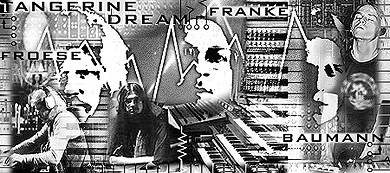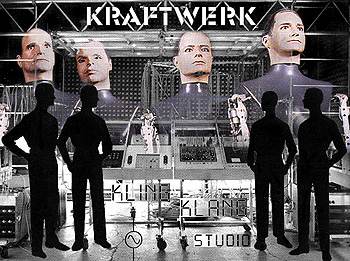D>Elektro 1.2 - |> expanded concept <|
|> Experiments | Sounds + Concepts |
All these experiments and developments didn't remain in the area of working in the studio.
In particular musicians like Klaus Schulze and Tangerine Dream now had the possibility also to develop their music in a live-situation along the parameters and structures they had developed while conversing with their instruments.

Through the improved possibilities for storing and triggering of especially generated sound, a complex and at the same time more open form of playing, improvising and composing became possible also on stage.
The more musical intelligence the musicians could delegate to, resp. feed into them, the more liberated they became from the more 'mechanical' parts of their playing. And the more intelligent and programmable these machines became, the more 'human' they could sound, in as much they became enabled to transform rhythms, sound-textures etc. way more flexible.
What was and remained important was the inventive usage of the possibilities at hand - a continuous exchange-play between human ideas and machine-possibilities.
Also Kraftwerk and CAN were introducing these with these new elements and experiences into their live performances.
With CAN, who where also following the concept of spontaneous composing when they played live, it was again Holger Czukay,
who introduced the most important experiments. As in the studio-work he wanted to provide a collage-and mixing situation to enable [or even force] the band to play and react on external, and in parts uncalculable, sound-material.
From 1977 on, during the CAN concerts he began to concentrate his work on playing with pre-recorded tapes, a short-wave receiver & transmitter, a dictaphone and a telephone.
| "When
- while still playing with CAN - I started to
play with the radio, I found that we just hadn't found one new
vocalist, but thousands! With the radio, so I thought, I could live
transmit our concerts. I wanted to become a kind of DJ of CAN - the people would have heard what I was just saying - and maybe some radio-amateur somewhere on the globe would have answered. His message would have become a part of the concert just as the band's music itself. The telephone was more a kind of a joke - during a concert I wanted to call someone and edit his voice into our music. That kind of interaction I wanted to achieve."
Holger Czukay
|
Also for Kraftwerk, whose music leaned heavily on machine-driven and computerized processes, the question between live- and studio-work/play became more and more absurd.
The individual, virtuoso-playing, which still was bound to playing traditional / acoustic instruments [and is particularly demanded durijng concerts], fades into the background, when producing this kind of advanced electronic music.
Typical studio-work, like the triggering of sounds and sequences, the mixing of various tracks and effects now dominated also the work of the group during their concerts.
It is about finding an optimal way to stimulate an "exchange of energy" between the musicians and the machine - in order to create corresponding "vibes" and music.
| "In
the Kling Klang Studio, which is the machine on which we are playing,
the entire studio becomes our instrument, and the process of mixing
becomes the playing itself."
Ralf Huetter [Kraftwerk]
|
Over the years not only the typical Kraftwerk-sounds were updated and made accessible to the evolving digital tools and possibilities - their whole rhyhtm-structures were re-vamped as well. Thus the original recordings became a kind of 'beta-version', which, from tour to tour underwent at times severe changes and variations - and / or were, as in typical today's DJ-manner were mixed and collaged anew.
Consequently, in 1991 Kraftwerk released an album entitled THE MIX - a compilation of newly recorded, resp. re-worked / re-mixed neu-eingespielter, bzw. ueberarbeiteter Kraftwerk 'classics'.
From very early on the group took notice and advantage of the parallel between their own preference of miniature-instruments and the ongoing development in computer-construction, to joing soft-and hardware into ever more compact and smaller units.
Kraftwerks own increasing computerization as well as their concept of totalmusic or the 'Gesamtkunstwerk' consequently brought them to the point, to re-construct their whole 'Kling Klang' studio into transportable units.
| "Our
studio is very compact: it fit's now into 10 units. We only need one
truck - very little, compared with the usual rock-standards. We like
small gadgets like pocket
calculators. That's for sure the way to go and how things will
develop."
Ralf Huetter [Kraftwerk]
|

| "Our
stdio is our electronic living-room,
our small house. So we take it everywhere with us on tour."
Ralf Huetter [Kraftwerk]
|
![The Man Machine[s] - live](../pics/mmlicoy.jpg)
| "The
tour showed the perfect
synthesis of man
and machine
working in harmony to create a piece of technical entertainment that,
considering its potential, was breathtaking in its economy of image
and sound. Was this a studio band playing live, or a live band playing the studio? Kraftwerk had once again neatly sidestepped the temptation to produce an overblown multi-media extravaganza, like Pink Floyd' s 'The Wall'. Instead of building their equipment up around like some kind of technological ego trip, they saw themselves presenting 'man and machine together in a friendly partnership of musical creation'."
Pascal Bussy
|
| D>Elektro |1.2.2| |>Sounds + Elements<| |
| |> Live - Studio | Remix | Miniaturealism <| |
| |>..Sounds + Elements..|> | |
| <| Rwd: | Man | Machine | Com. | | |
| |> Fwd: | Effects | Developments | 1 | | |